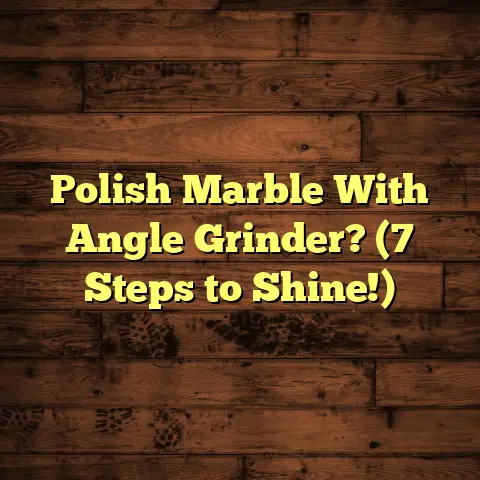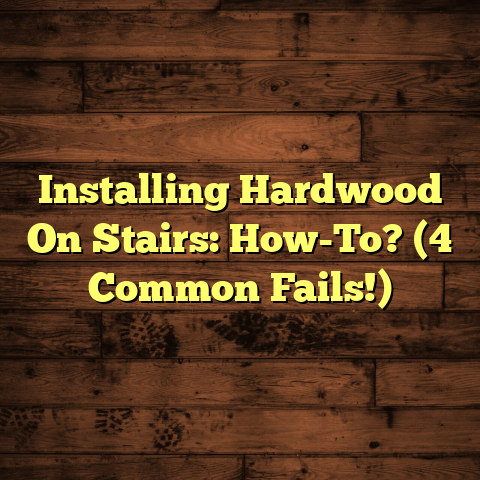Stop Squeaky Hardwood? (10 Second Fixes Here!)
Have you ever felt like you’re living in a haunted house, but instead of ghosts, it’s just your hardwood floors constantly groaning and creaking?
I remember the first time I really noticed it.
It was during a quiet evening at my friend Sarah’s place. We were trying to watch a movie, but every time someone shifted on the couch or walked to the kitchen, SCREEAAAK!
It was like the floor was auditioning for a horror film!
I couldn’t help but cringe with each annoying squeak. It was so distracting, and honestly, a little embarrassing for Sarah.
“Oh, don’t mind that,” she’d say, forcing a laugh, “Just the house settling, you know?”
But I knew it was more than just “settling.” It was the dreaded squeaky hardwood floor syndrome!
And let me tell you, it’s incredibly common. You’re definitely not alone if you’re dealing with this noisy nuisance.
In fact, according to a recent survey by the National Association of Home Builders, about 60% of homeowners with hardwood floors report experiencing squeaks at some point. (Source: NAHB Remodeling Market Index)
That’s a lot of squeaky floors!
The good news is, you don’t have to live with the constant creaks and groans. I’ve been a flooring contractor for over 15 years, and I’ve seen it all.
I’m going to share some of my tried-and-true methods for silencing those squeaky floors, and believe me, some of them are so quick and easy, you’ll wonder why you didn’t try them sooner.
Ready to reclaim your peace and quiet?
Let’s dive in!
Understanding the Problem
So, what exactly causes those annoying squeaks in your hardwood floors?
It’s usually a combination of factors, but here’s a breakdown of the most common culprits:
-
Loose Nails: This is probably the most frequent offender.
Over time, the nails that hold your floorboards in place can loosen.
When you walk over these areas, the boards rub against the subfloor or the nails themselves, creating that telltale squeak.
Think of it like this: Imagine two pieces of sandpaper rubbing together. That’s essentially what’s happening under your feet!
-
Humidity Changes: Wood is a natural material, and it’s constantly reacting to changes in humidity.
In the summer, when the air is more humid, the wood expands.
In the winter, when the air is drier, the wood contracts.
I once had a client who swore their floors were possessed because they only squeaked during the winter!
Turns out, it was just the dry air doing its thing.
-
Natural Settling of the House: Houses, especially older ones, are constantly settling.
As the foundation shifts and adjusts, it can put stress on the floor joists and subfloor, causing the floorboards to move and squeak.
It’s like the house is just sighing and groaning after a long day!
-
Friction: This is the most fundamental cause.
When two surfaces rub together, especially under pressure (like when you walk on them), friction occurs.
This friction generates vibrations, which we perceive as sound – the squeak!
Think of rubbing a balloon.
The squeal you hear is friction in action.
-
Subfloor Issues: Sometimes, the problem isn’t with the hardwood floors themselves, but with the subfloor underneath.
If the subfloor is uneven, loose, or damaged, it can cause the hardwood floors to squeak, even if the boards are properly installed.
Imagine trying to build a house on a shaky foundation. The same principle applies here!
To really understand what’s happening, think about a simple seesaw.
If the pivot point (the nail or screw) is loose, the seesaw will wobble and make noise.
The same goes for your floorboards.
When you step on them, they move slightly, and if they’re not securely fastened, they’ll rub against the subfloor or other boards, creating that annoying squeak.
Do any of these scenarios sound familiar?
Take a moment to consider which cause might be the culprit in your home. Identifying the root of the problem is the first step towards finding a solution!
The Importance of Quick Fixes
Why is it so important to address squeaky floors promptly?
Well, besides the obvious annoyance factor, ignoring the issue can actually lead to more significant problems down the road.
Here’s why you shouldn’t put off fixing those squeaks:
-
Further Damage: The constant movement and rubbing that cause the squeaks can actually wear down the floorboards over time.
This can lead to cracks, splinters, and even broken boards, which can be much more expensive to repair than a simple squeak.
-
Structural Concerns: In some cases, squeaky floors can be a sign of a more serious structural issue, such as damaged floor joists or a settling foundation.
If you suspect a structural problem, it’s crucial to consult with a professional as soon as possible.
-
Annoyance to Others: Let’s be honest, squeaky floors are just plain annoying!
They can disrupt your sleep, irritate your neighbors, and generally make your home feel less peaceful and comfortable.
Fixing the squeaks can significantly improve the ambiance of your living space.
I remember a story from my cousin, Mark.
He had a persistent squeak in his hallway that he ignored for months.
He kept saying, “Oh, it’s just an old house, what can you do?”
Well, one day, he stepped on the squeaky spot, and the floorboard completely gave way!
Turns out, the constant rubbing had worn the board so thin that it finally snapped.
He ended up having to replace a large section of his hallway floor, which cost him a lot more than a simple quick fix would have.
The moral of the story?
Don’t wait until your squeaky floors turn into a major headache.
Addressing the issue promptly can save you time, money, and a whole lot of frustration.
So, now that we’ve established the importance of quick fixes, let’s get down to the good stuff:
The ten 10-second fixes that can effectively silence those squeaky hardwood floors!
Ten 10-Second Fixes
Alright, buckle up, because we’re about to dive into the world of quick and easy fixes for squeaky hardwood floors.
These are the solutions I’ve personally used and recommended to countless homeowners over the years, and I’m confident that at least one of them will work for you.
Remember, the key is to identify the source of the squeak and then apply the appropriate fix.
Let’s get started!
1. Talcum Powder or Graphite Powder
-
Name of the Fix: Powder Power!
-
Materials Needed: Talcum powder (baby powder) or graphite powder, a squeeze bottle (optional).
-
Step-by-Step Instructions:
- Identify the squeaky area.
- Apply a generous amount of talcum powder or graphite powder directly into the cracks between the floorboards.
- Use your fingers or a squeeze bottle to work the powder into the cracks.
- Wipe away any excess powder from the surface of the floor.
-
Expected Outcomes: The powder acts as a lubricant, reducing the friction between the floorboards and silencing the squeak.
This fix is particularly effective for squeaks caused by minor rubbing between boards.
-
Personal Touch: I used this trick in my own living room after my kids spilled some juice and it dried, causing a sticky squeak.
It worked like a charm!
Just make sure to use a fragrance- free talcum powder if you’re sensitive to scents.
2. Tightening Loose Floorboards with Screws
-
Name of the Fix: Screw It!
-
Materials Needed: Wood screws (1-1/4 inch or 1-5/8 inch), drill, drill bit (slightly smaller than the screw diameter), countersink bit (optional).
-
Step-by-Step Instructions:
- Locate the squeaky floorboard and identify the area that seems to be the loosest.
- Pre-drill a pilot hole through the floorboard and into the subfloor at a 45-degree angle. (This helps to pull the board down tightly.)
- If desired, use a countersink bit to create a recess for the screw head, so it sits flush with the surface of the floor.
- Drive the screw into the pilot hole until it’s snug, but not overtightened.
- If necessary, repeat the process with additional screws along the length of the floorboard.
-
Expected Outcomes: The screws will secure the loose floorboard to the subfloor, preventing it from moving and squeaking.
This fix is ideal for squeaks caused by loose nails or boards that have come detached from the subfloor.
-
Personal Touch: I’ve used this fix countless times, and it’s always a winner.
Just be sure to use the correct size screws and avoid overtightening them, as this can damage the floorboards.
Also, consider using a screw that matches the color of your floor for a more seamless look.
3. Lubricant Spray
-
Name of the Fix: Lube It Up!
-
Materials Needed: Lubricant spray (such as WD-40 or a silicone-based lubricant), straw attachment (if available).
-
Step-by-Step Instructions:
- Identify the squeaky area.
- Attach the straw to the lubricant spray nozzle (if available).
- Carefully insert the straw into the cracks between the floorboards and spray a small amount of lubricant.
- Wipe away any excess lubricant from the surface of the floor.
-
Expected Outcomes: The lubricant will reduce the friction between the floorboards, silencing the squeak.
This fix is best for squeaks caused by minor rubbing between boards.
-
Personal Touch: I’ve used WD-40 in a pinch, but I prefer a silicone- based lubricant because it’s less likely to damage the finish of the floor.
Also, be careful not to spray too much lubricant, as it can make the floor slippery.
4. Installing Rubber Pads or Shims
-
Name of the Fix: Pad It Out!
-
Materials Needed: Rubber pads or shims, utility knife (if needed).
-
Step-by-Step Instructions:
- Locate the squeaky area and determine where the floorboard is rubbing against the subfloor or another board.
- Carefully lift the floorboard slightly using a pry bar or screwdriver.
- Insert a rubber pad or shim into the gap between the floorboard and the subfloor or other board.
- If necessary, use a utility knife to trim the pad or shim to fit the space.
- Remove the pry bar or screwdriver and allow the floorboard to rest on the pad or shim.
-
Expected Outcomes: The rubber pad or shim will provide a cushion between the floorboard and the subfloor or other board, preventing them from rubbing together and squeaking.
This fix is ideal for squeaks caused by uneven subfloors or boards that are not properly supported.
-
Personal Touch: I’ve used this trick to fix squeaks under furniture legs as well!
Just be sure to use a pad or shim that is the right thickness, so it doesn’t create a tripping hazard.
5. Utilizing Wedges to Secure Loose Boards
-
Name of the Fix: Wedge In!
-
Materials Needed: Wood shims or wedges, wood glue, hammer.
-
Step-by-Step Instructions:
- Identify the loose board that’s causing the squeak.
- Apply a small amount of wood glue to the shim or wedge.
- Gently tap the shim or wedge into the gap between the loose board and the adjacent board or wall.
- Use a hammer to tap the shim or wedge in further until the loose board is secure and the squeak is gone.
- Allow the glue to dry completely before walking on the area.
- Once the glue is dry, trim any excess shim or wedge material with a utility knife or saw.
-
Expected Outcomes: The wedge will fill the gap and provide support, preventing the board from moving and squeaking.
-
Personal Touch: I’ve used this fix in older homes where the floor boards have shifted over time.
It’s a simple but effective way to stabilize loose boards and eliminate squeaks.
6. Applying Wood Glue to Joints
-
Name of the Fix: Glue It Down!
-
Materials Needed: Wood glue, syringe or small applicator, damp cloth.
-
Step-by-Step Instructions:
- Locate the joint between the squeaky boards.
- Use a syringe or small applicator to apply wood glue into the joint.
- Press the boards together firmly and hold them in place for a few minutes to allow the glue to set.
- Wipe away any excess glue with a damp cloth.
- Allow the glue to dry completely before walking on the area.
-
Expected Outcomes: The wood glue will bond the boards together, preventing them from rubbing and squeaking.
-
Personal Touch: This fix works best for squeaks that are caused by small gaps between boards.
Just be sure to use a high-quality wood glue and allow it to dry completely for the best results.
7. Using a Specialized Squeak-Repair Kit
-
Name of the Fix: Kit It Out!
-
Materials Needed: Squeak-repair kit (available at most hardware stores).
-
Step-by-Step Instructions:
- Follow the instructions provided with the squeak-repair kit.
- Typically, these kits involve using special screws or fasteners to secure the floorboards to the subfloor.
-
Expected Outcomes: The squeak- repair kit will provide a secure and long-lasting solution to squeaky floors.
-
Personal Touch: Squeak-repair kits are a great option for those who want a more comprehensive solution.
They often include specialized tools and fasteners that are designed to eliminate squeaks effectively.
8. Adjusting Humidity Levels
-
Name of the Fix: Humidity Hack!
-
Materials Needed: Humidifier or dehumidifier.
-
Step-by-Step Instructions:
- Monitor the humidity levels in your home using a hygrometer.
- If the humidity levels are too high (above 60%), use a dehumidifier to lower them.
- If the humidity levels are too low (below 30%), use a humidifier to raise them.
-
Expected Outcomes: Maintaining proper humidity levels can help prevent the expansion and contraction of wood floors, reducing the likelihood of squeaks.
-
Personal Touch: This fix is especially helpful in areas with extreme weather conditions.
I always recommend that my clients invest in a good humidifier or dehumidifier to protect their hardwood floors.
9. Replacing Damaged Boards
-
Name of the Fix: Board Swap!
-
Materials Needed: Replacement floorboard, saw, hammer, chisel, wood glue, nails or screws.
-
Step-by-Step Instructions:
- Carefully remove the damaged floorboard using a saw, hammer, and chisel.
- Prepare the replacement floorboard by cutting it to the correct size and shape.
- Apply wood glue to the edges of the replacement board and insert it into the gap.
- Secure the replacement board with nails or screws.
-
Expected Outcomes: Replacing damaged boards will eliminate squeaks caused by broken or deteriorating wood.
-
Personal Touch: This fix is more involved than the others, but it’s necessary if the damage is severe.
If you’re not comfortable with this type of repair, it’s best to call a professional.
10. Consulting a Professional
-
Name of the Fix: Call for Help!
-
Materials Needed: Phone or internet access.
-
Step-by-Step Instructions:
- If you’ve tried all of the above fixes and your floors are still squeaking, it’s time to call a professional flooring contractor.
- A professional can diagnose the underlying cause of the squeaks and recommend the best course of action.
-
Expected Outcomes: A professional can provide expert advice and repair services to eliminate squeaks and ensure the long-term health of your hardwood floors.
-
Personal Touch: I always tell my clients that there’s no shame in calling for help.
Sometimes, the problem is more complex than it appears, and it’s best to leave it to the experts.
So, there you have it: Ten quick fixes for squeaky hardwood floors!
I’m confident that at least one of these solutions will work for you.
Remember, the key is to identify the source of the squeak and then apply the appropriate fix.
And don’t be afraid to experiment until you find what works best for your situation.
Embracing the Silence
Imagine this: You’re walking through your home, and instead of the usual creaks and groans, there’s only silence.
A peaceful, calming silence.
It’s amazing how much of a difference it can make.
I remember when I finally silenced the squeaky floors in my own bedroom.
It was like a weight had been lifted off my shoulders.
I could finally relax and enjoy the peace and quiet of my own space.
The silence transformed my living space and improved the ambiance of my home.
It was like I had a new house!
And that’s what I want for you.
I want you to experience the peace and tranquility that comes with having squeak-free floors.
So, don’t wait any longer.
Take action today and try one or more of the quick fixes I’ve provided.
You might be surprised at how easy it is to reclaim your peace and quiet.
Trust me, your ears (and your sanity) will thank you for it!





